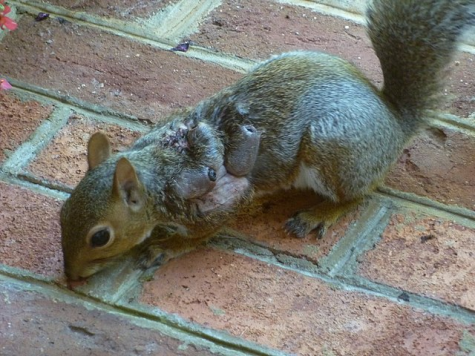Botfly infestation: Will Guilford’s squirrels survive and are we next on the menu?

The Guilford squirrels have garnered lots of attention in recent years. From candid videos of the hungry rodents digging in campus trash cans to the creation of two separate Instagram pages dedicated to their daily lives, it’s no question that they boost campus morale. However, this fall our squirrels are suffering and the perpetrator is rather unsightly. Tree squirrel botflies, scientifically known as Cuterebra emasculator Fitch, can be seen squirming under the skin of almost every squirrel on campus, and the squirrels look pretty uncomfortable.
First-year student Ella Barton-Biegelson is a frequent squirrel watcher and recorder, and she is rather distraught about our furry neighbors’ current state.
“I see squirrels limping around trying to scratch themselves and they look so uncomfortable,” said the self-proclaimed squirrel enthusiast. “I also have seen the botflies on the ground around campus and it’s honestly gross.”
“It’s gross…(but) it poses zero threat to human health on campus,” says Guilford biology professor and published ecologist Christine Stracey. She clarified that the species that we have on campus only infect squirrels.
Many believe that the flies lay eggs in the skin of the rodent but this hasn’t been proven to be true.
“Scientists aren’t completely sure, but they think that they hatch in the leaf litter,” Stracey said. “…If a squirrel comes across one it can swallow it or it will enter another orifice and the holes we see on the skin are their air holes…eventually, they (botflies) burrow out.”
According to Stracey, the fly is native to this area, so it poses no ecological threat to the squirrel population. She said that if a squirrel is in poor health and contracts the flies, it can lead to anemia and death, which is why conservationists will remove the parasite if the squirrel is brought to a rehabilitation center. Otherwise, however, there is no mass effort to treat the general squirrel population.
The University of Florida’s Department of Agriculture states that botfly larvae can’t survive without their hosts, so if botflies kill the squirrels and chipmunks they infect, they cannot reproduce. However, botflies can cause temporary reproductive issues for their hosts. Pregnant or nursing squirrels can see a decrease in milk production, which leads to the death of their offspring.
The larvae also have the potential to interfere with the position of chipmunk testes, depending on where in the abdomen the larvae are located. However, this is temporary, and the larvae don’t consume the testes, as scientists previously believed.
Stracey claimed that squirrels can handle about one to five of these parasites at a time, and unless they were already in poor health, they’ll just be itchy for the remainder of the parasites’ stay.
Botfly season in squirrels spans the month of September, and, according to Stracey, some states adjusted their squirrel hunting season to avoid the botflies.
“I don’t eat squirrels but I definitely wouldn’t eat one with botflies in it,” Stracey joked. “They are gross… (but) by the winter season they’re gone.”
Stracey said that the loose larvae that Barton-Biegelson saw wiggling on the paths around campus were not botflies. “Those are the larvae (of) a species of beetle,” she said.
This is consistent with the University of Florida’s statement about the parasites’ inability to survive without the safety of their hosts – if they were loose on the ground, they wouldn’t still be alive.
It is no question that botflies are horrific to look at. They not only make our skin crawl, but also the skin of the unfortunate squirrels that they’ve chosen as hosts.
Fortunately, we humans who inhabit the Guilford campus won’t be infected with botflies anytime soon, and come the end of September, the campus squirrels likely will be back to their normal Cheeto-stealing selves.






